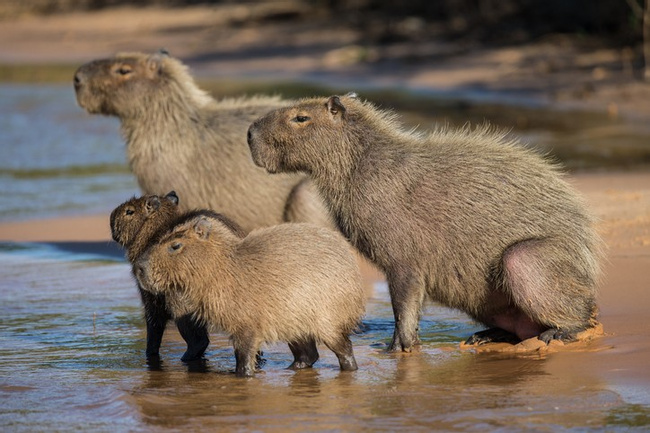Capybara, Rodent - Vertebrate
Capybaras (Hydrochoerus hydrochaeris) are the world’s largest rodents. They look like oversized guinea pigs and they can be found around the rivers and lakes of Central and South America.

More about The Capybara
Habitat
Capybaras live in lowlands, including plains and tropical forests. They are always found near water and prefer swampy, marshy, and grassy areas bordering rivers, ponds, and lakes.
They live in eastern Panama and South American countries like Colombia, Venezuela, Peru, Ecuador, Bolivia, Argentina, and Brazil.
Physical Description
Capybaras have large, barrel-shaped bodies and light brown, shaggy hair. They have webbed feet (with four toes on their front feet and three toes on their back feet) that they use for swimming and walking. Like other rodents, they have long, ever-growing teeth.
Interesting Biology
These very social animals are usually found in groups of 10-30 individuals, although they will sometimes form groups of up to 100 when sharing a territory. They communicate using chirps, whistles, barks, and purrs. They also use warning barks to scare away predators when threatened.
Capybaras communicate extensively by smell. They have a pair of scent glands that they use to mark territory and communicate with other individuals; males sometimes mark females as well.
Similar to hippos, these animals have eyes, ears and nostrils on the top of their head. This allows their head to be above water while the rest of their body remains underwater—this is valuable for hiding from predators. Capybaras can stay under water for five minutes to escape predators.
There is usually one alpha male that is in charge of several adult females and babies. This male will typically be found in the center of the group, whereas less dominant males are scattered on the outskirts.
Capybaras usually breed during the wet season, with breeding taking place in the water. Females usually have one litter of babies each year. After only a few days the newborns join the group. They will graze early on and nurse for around 16 weeks.
Diet
Capybaras eat water plants and grasses. An adult can eat 6 to 8 pounds of grass per day! During the dry season, when grass is less plentiful, capybaras eat grains, melons, squashes, and reeds. They’ll sometimes even eat their own feces to retain beneficial bacterial that help with digesting fiber.
Height/Weight
Capybaras range in length from 42 to 53 inches and stand about 2 feet tall at their shoulders. Adults average around 100 pounds (49 kg).
Brief Taxonomy
Order: Rodentia
Family: Hydrochoeridae
Sources
Norwalk, Ronald M. 1999. Walker’s Mammals of the World – Volume I (6th edition).
Similar Profiles
It's more than just having a good time or visiting beautiful places (although that's absolutely a part of it!), it's about being part of a unique experience that stays with you.



